Change Leadership Models and Organizational Implications Report
VerifiedAdded on 2023/05/28
|11
|2608
|438
Report
AI Summary
This report delves into the critical aspects of change management, focusing on the pivotal role of leadership in driving organizational transformations. It explores various change leadership models, including situational and transformational leadership, highlighting their application and impact within organizations. The report analyzes the implications of change leadership, emphasizing the importance of employee engagement, adaptability, and a supportive work environment. It also provides recommendations for leaders, such as involving employees in the change process, fostering open communication, and demonstrating empathy. The report underscores the significance of effective leadership in navigating technological advancements, organizational restructuring, and evolving consumer behaviors, ultimately aiming to equip leaders with strategies for successful organizational change. The report covers the various models of change leadership, including Situational Leadership, Framework for Leadership, Agreement and Certainty Matrix and Transformational Leadership and implications of change leadership in organizations. The recommendations are also discussed which can help the organization in the event of organizational change.
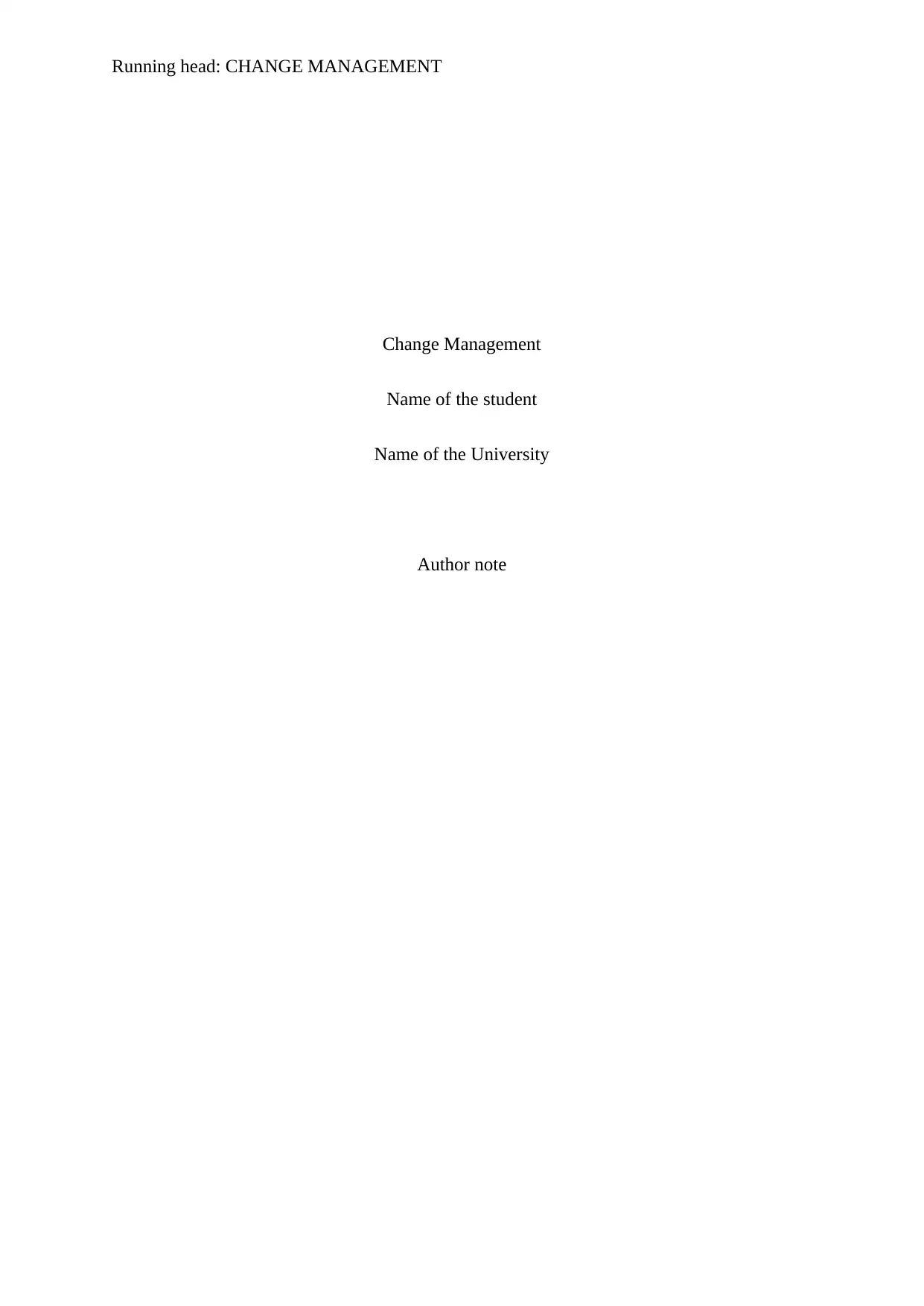
Running head: CHANGE MANAGEMENT
Change Management
Name of the student
Name of the University
Author note
Change Management
Name of the student
Name of the University
Author note
Paraphrase This Document
Need a fresh take? Get an instant paraphrase of this document with our AI Paraphraser
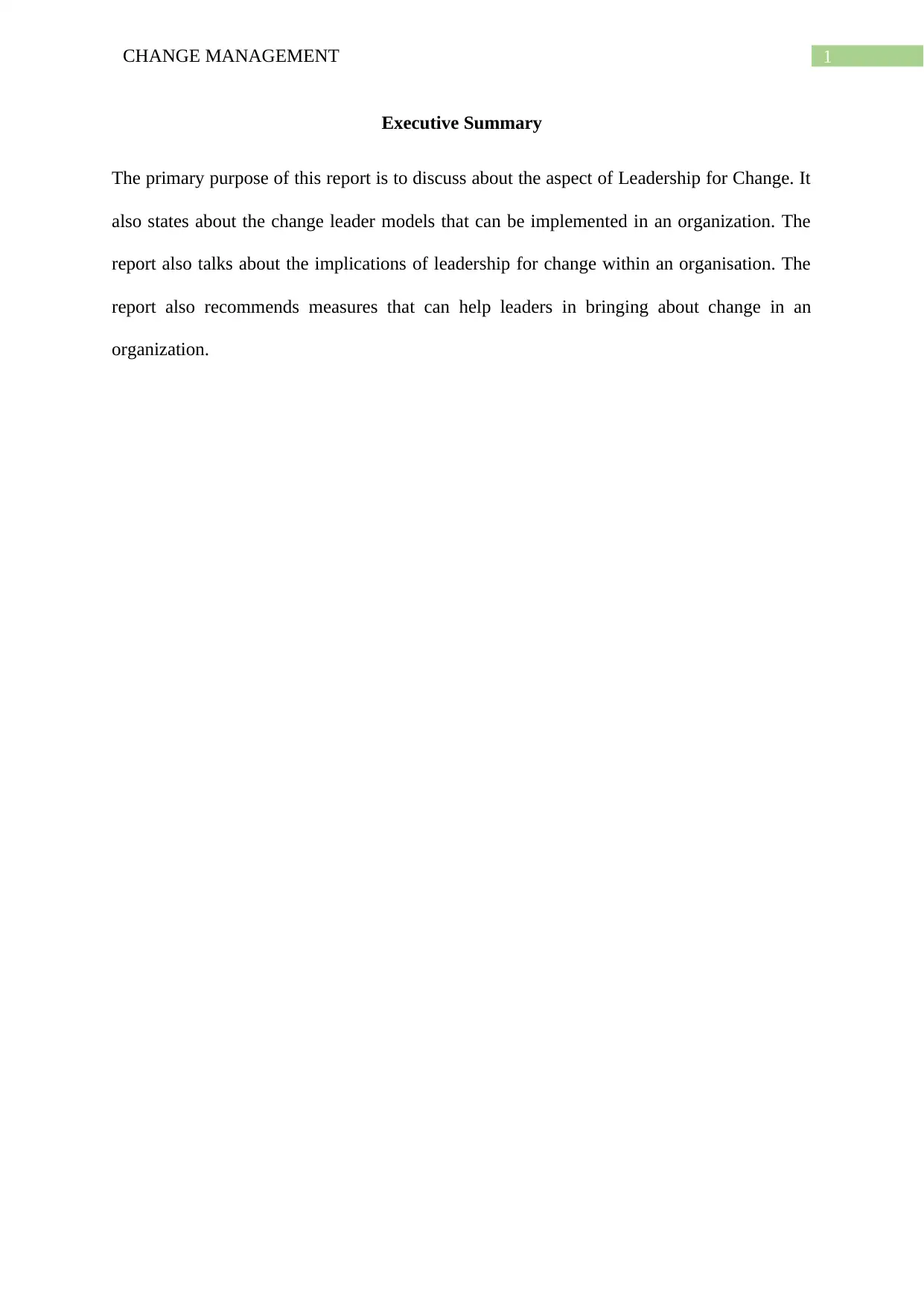
1CHANGE MANAGEMENT
Executive Summary
The primary purpose of this report is to discuss about the aspect of Leadership for Change. It
also states about the change leader models that can be implemented in an organization. The
report also talks about the implications of leadership for change within an organisation. The
report also recommends measures that can help leaders in bringing about change in an
organization.
Executive Summary
The primary purpose of this report is to discuss about the aspect of Leadership for Change. It
also states about the change leader models that can be implemented in an organization. The
report also talks about the implications of leadership for change within an organisation. The
report also recommends measures that can help leaders in bringing about change in an
organization.
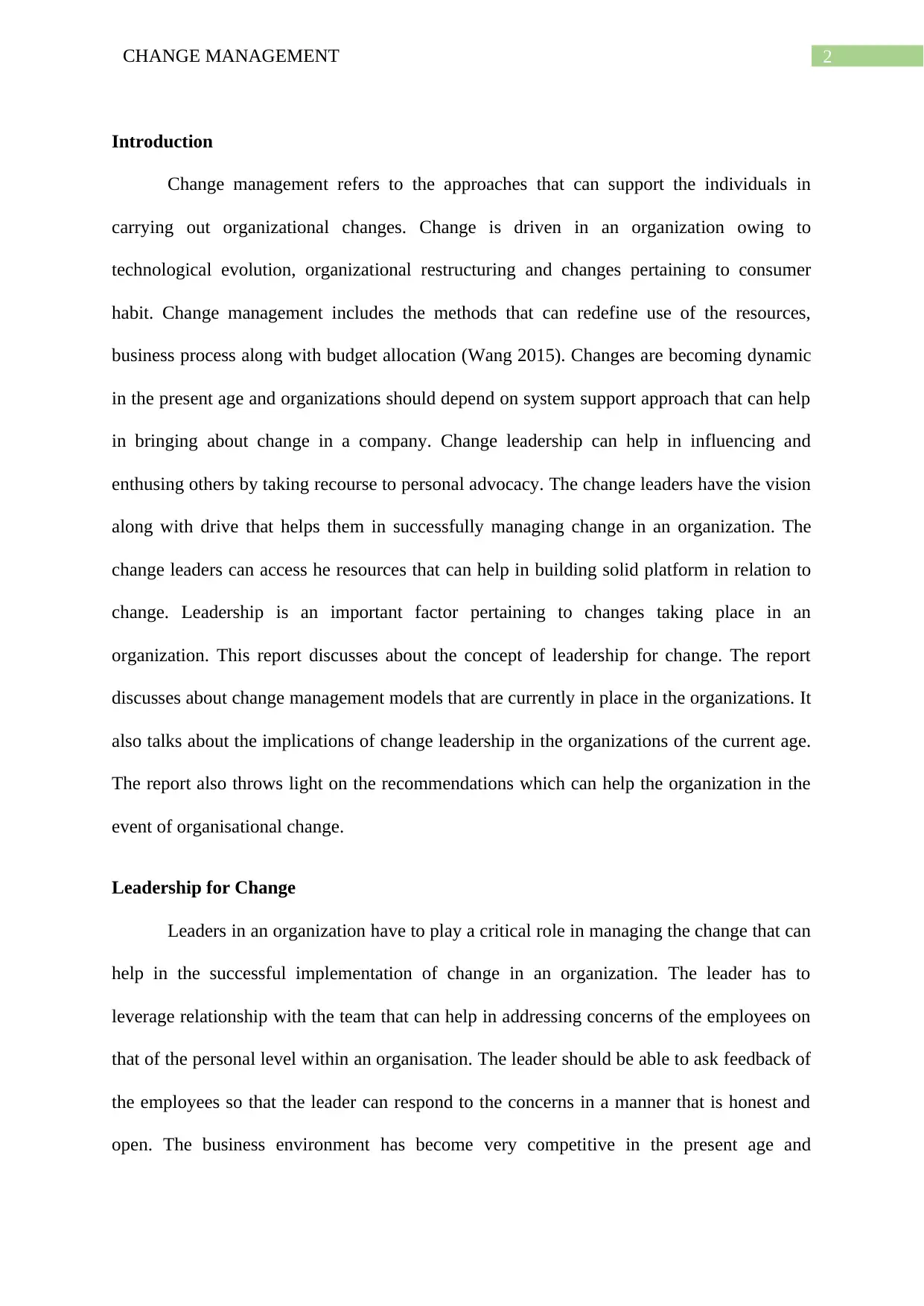
2CHANGE MANAGEMENT
Introduction
Change management refers to the approaches that can support the individuals in
carrying out organizational changes. Change is driven in an organization owing to
technological evolution, organizational restructuring and changes pertaining to consumer
habit. Change management includes the methods that can redefine use of the resources,
business process along with budget allocation (Wang 2015). Changes are becoming dynamic
in the present age and organizations should depend on system support approach that can help
in bringing about change in a company. Change leadership can help in influencing and
enthusing others by taking recourse to personal advocacy. The change leaders have the vision
along with drive that helps them in successfully managing change in an organization. The
change leaders can access he resources that can help in building solid platform in relation to
change. Leadership is an important factor pertaining to changes taking place in an
organization. This report discusses about the concept of leadership for change. The report
discusses about change management models that are currently in place in the organizations. It
also talks about the implications of change leadership in the organizations of the current age.
The report also throws light on the recommendations which can help the organization in the
event of organisational change.
Leadership for Change
Leaders in an organization have to play a critical role in managing the change that can
help in the successful implementation of change in an organization. The leader has to
leverage relationship with the team that can help in addressing concerns of the employees on
that of the personal level within an organisation. The leader should be able to ask feedback of
the employees so that the leader can respond to the concerns in a manner that is honest and
open. The business environment has become very competitive in the present age and
Introduction
Change management refers to the approaches that can support the individuals in
carrying out organizational changes. Change is driven in an organization owing to
technological evolution, organizational restructuring and changes pertaining to consumer
habit. Change management includes the methods that can redefine use of the resources,
business process along with budget allocation (Wang 2015). Changes are becoming dynamic
in the present age and organizations should depend on system support approach that can help
in bringing about change in a company. Change leadership can help in influencing and
enthusing others by taking recourse to personal advocacy. The change leaders have the vision
along with drive that helps them in successfully managing change in an organization. The
change leaders can access he resources that can help in building solid platform in relation to
change. Leadership is an important factor pertaining to changes taking place in an
organization. This report discusses about the concept of leadership for change. The report
discusses about change management models that are currently in place in the organizations. It
also talks about the implications of change leadership in the organizations of the current age.
The report also throws light on the recommendations which can help the organization in the
event of organisational change.
Leadership for Change
Leaders in an organization have to play a critical role in managing the change that can
help in the successful implementation of change in an organization. The leader has to
leverage relationship with the team that can help in addressing concerns of the employees on
that of the personal level within an organisation. The leader should be able to ask feedback of
the employees so that the leader can respond to the concerns in a manner that is honest and
open. The business environment has become very competitive in the present age and
⊘ This is a preview!⊘
Do you want full access?
Subscribe today to unlock all pages.

Trusted by 1+ million students worldwide
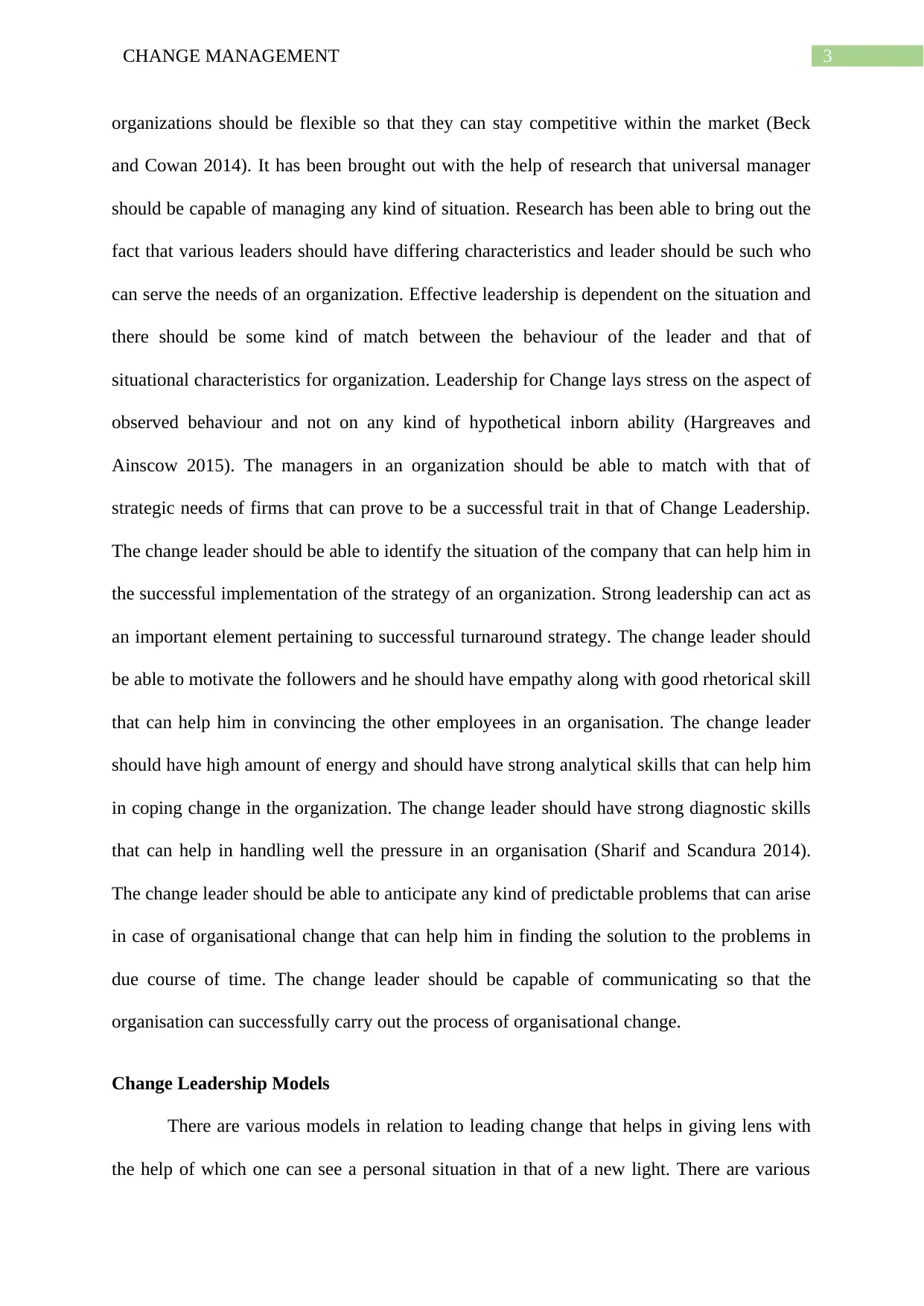
3CHANGE MANAGEMENT
organizations should be flexible so that they can stay competitive within the market (Beck
and Cowan 2014). It has been brought out with the help of research that universal manager
should be capable of managing any kind of situation. Research has been able to bring out the
fact that various leaders should have differing characteristics and leader should be such who
can serve the needs of an organization. Effective leadership is dependent on the situation and
there should be some kind of match between the behaviour of the leader and that of
situational characteristics for organization. Leadership for Change lays stress on the aspect of
observed behaviour and not on any kind of hypothetical inborn ability (Hargreaves and
Ainscow 2015). The managers in an organization should be able to match with that of
strategic needs of firms that can prove to be a successful trait in that of Change Leadership.
The change leader should be able to identify the situation of the company that can help him in
the successful implementation of the strategy of an organization. Strong leadership can act as
an important element pertaining to successful turnaround strategy. The change leader should
be able to motivate the followers and he should have empathy along with good rhetorical skill
that can help him in convincing the other employees in an organisation. The change leader
should have high amount of energy and should have strong analytical skills that can help him
in coping change in the organization. The change leader should have strong diagnostic skills
that can help in handling well the pressure in an organisation (Sharif and Scandura 2014).
The change leader should be able to anticipate any kind of predictable problems that can arise
in case of organisational change that can help him in finding the solution to the problems in
due course of time. The change leader should be capable of communicating so that the
organisation can successfully carry out the process of organisational change.
Change Leadership Models
There are various models in relation to leading change that helps in giving lens with
the help of which one can see a personal situation in that of a new light. There are various
organizations should be flexible so that they can stay competitive within the market (Beck
and Cowan 2014). It has been brought out with the help of research that universal manager
should be capable of managing any kind of situation. Research has been able to bring out the
fact that various leaders should have differing characteristics and leader should be such who
can serve the needs of an organization. Effective leadership is dependent on the situation and
there should be some kind of match between the behaviour of the leader and that of
situational characteristics for organization. Leadership for Change lays stress on the aspect of
observed behaviour and not on any kind of hypothetical inborn ability (Hargreaves and
Ainscow 2015). The managers in an organization should be able to match with that of
strategic needs of firms that can prove to be a successful trait in that of Change Leadership.
The change leader should be able to identify the situation of the company that can help him in
the successful implementation of the strategy of an organization. Strong leadership can act as
an important element pertaining to successful turnaround strategy. The change leader should
be able to motivate the followers and he should have empathy along with good rhetorical skill
that can help him in convincing the other employees in an organisation. The change leader
should have high amount of energy and should have strong analytical skills that can help him
in coping change in the organization. The change leader should have strong diagnostic skills
that can help in handling well the pressure in an organisation (Sharif and Scandura 2014).
The change leader should be able to anticipate any kind of predictable problems that can arise
in case of organisational change that can help him in finding the solution to the problems in
due course of time. The change leader should be capable of communicating so that the
organisation can successfully carry out the process of organisational change.
Change Leadership Models
There are various models in relation to leading change that helps in giving lens with
the help of which one can see a personal situation in that of a new light. There are various
Paraphrase This Document
Need a fresh take? Get an instant paraphrase of this document with our AI Paraphraser
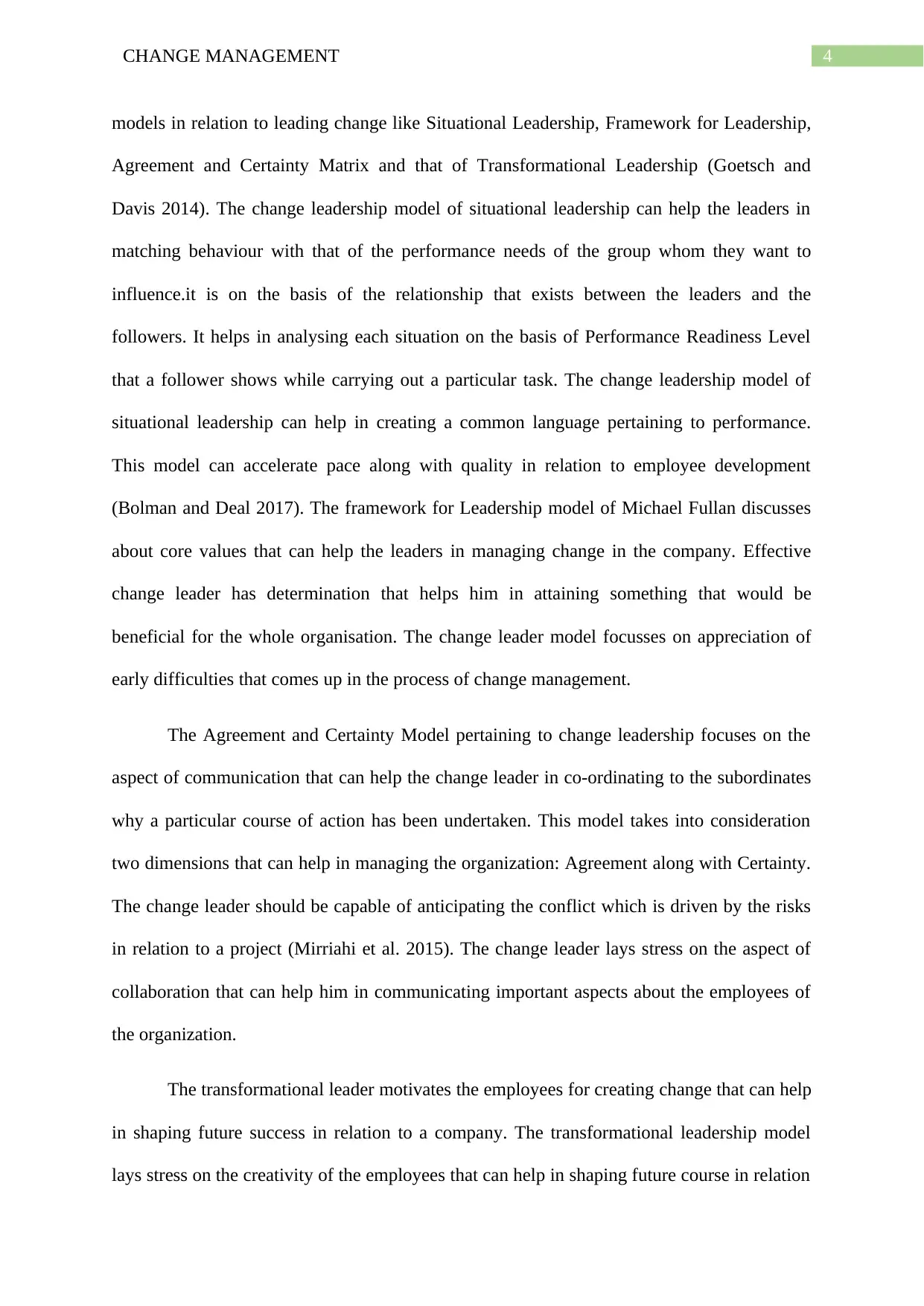
4CHANGE MANAGEMENT
models in relation to leading change like Situational Leadership, Framework for Leadership,
Agreement and Certainty Matrix and that of Transformational Leadership (Goetsch and
Davis 2014). The change leadership model of situational leadership can help the leaders in
matching behaviour with that of the performance needs of the group whom they want to
influence.it is on the basis of the relationship that exists between the leaders and the
followers. It helps in analysing each situation on the basis of Performance Readiness Level
that a follower shows while carrying out a particular task. The change leadership model of
situational leadership can help in creating a common language pertaining to performance.
This model can accelerate pace along with quality in relation to employee development
(Bolman and Deal 2017). The framework for Leadership model of Michael Fullan discusses
about core values that can help the leaders in managing change in the company. Effective
change leader has determination that helps him in attaining something that would be
beneficial for the whole organisation. The change leader model focusses on appreciation of
early difficulties that comes up in the process of change management.
The Agreement and Certainty Model pertaining to change leadership focuses on the
aspect of communication that can help the change leader in co-ordinating to the subordinates
why a particular course of action has been undertaken. This model takes into consideration
two dimensions that can help in managing the organization: Agreement along with Certainty.
The change leader should be capable of anticipating the conflict which is driven by the risks
in relation to a project (Mirriahi et al. 2015). The change leader lays stress on the aspect of
collaboration that can help him in communicating important aspects about the employees of
the organization.
The transformational leader motivates the employees for creating change that can help
in shaping future success in relation to a company. The transformational leadership model
lays stress on the creativity of the employees that can help in shaping future course in relation
models in relation to leading change like Situational Leadership, Framework for Leadership,
Agreement and Certainty Matrix and that of Transformational Leadership (Goetsch and
Davis 2014). The change leadership model of situational leadership can help the leaders in
matching behaviour with that of the performance needs of the group whom they want to
influence.it is on the basis of the relationship that exists between the leaders and the
followers. It helps in analysing each situation on the basis of Performance Readiness Level
that a follower shows while carrying out a particular task. The change leadership model of
situational leadership can help in creating a common language pertaining to performance.
This model can accelerate pace along with quality in relation to employee development
(Bolman and Deal 2017). The framework for Leadership model of Michael Fullan discusses
about core values that can help the leaders in managing change in the company. Effective
change leader has determination that helps him in attaining something that would be
beneficial for the whole organisation. The change leader model focusses on appreciation of
early difficulties that comes up in the process of change management.
The Agreement and Certainty Model pertaining to change leadership focuses on the
aspect of communication that can help the change leader in co-ordinating to the subordinates
why a particular course of action has been undertaken. This model takes into consideration
two dimensions that can help in managing the organization: Agreement along with Certainty.
The change leader should be capable of anticipating the conflict which is driven by the risks
in relation to a project (Mirriahi et al. 2015). The change leader lays stress on the aspect of
collaboration that can help him in communicating important aspects about the employees of
the organization.
The transformational leader motivates the employees for creating change that can help
in shaping future success in relation to a company. The transformational leadership model
lays stress on the creativity of the employees that can help in shaping future course in relation
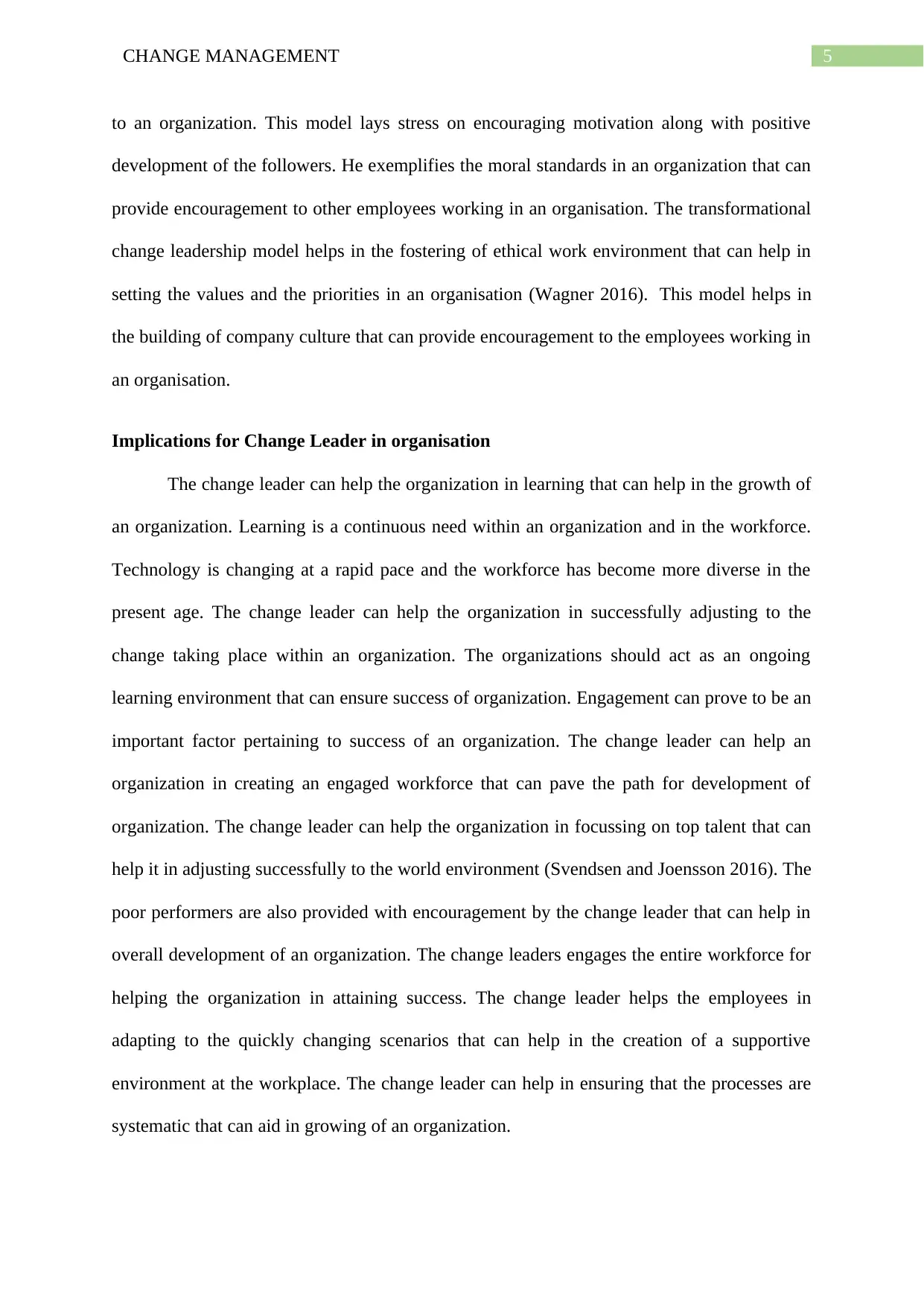
5CHANGE MANAGEMENT
to an organization. This model lays stress on encouraging motivation along with positive
development of the followers. He exemplifies the moral standards in an organization that can
provide encouragement to other employees working in an organisation. The transformational
change leadership model helps in the fostering of ethical work environment that can help in
setting the values and the priorities in an organisation (Wagner 2016). This model helps in
the building of company culture that can provide encouragement to the employees working in
an organisation.
Implications for Change Leader in organisation
The change leader can help the organization in learning that can help in the growth of
an organization. Learning is a continuous need within an organization and in the workforce.
Technology is changing at a rapid pace and the workforce has become more diverse in the
present age. The change leader can help the organization in successfully adjusting to the
change taking place within an organization. The organizations should act as an ongoing
learning environment that can ensure success of organization. Engagement can prove to be an
important factor pertaining to success of an organization. The change leader can help an
organization in creating an engaged workforce that can pave the path for development of
organization. The change leader can help the organization in focussing on top talent that can
help it in adjusting successfully to the world environment (Svendsen and Joensson 2016). The
poor performers are also provided with encouragement by the change leader that can help in
overall development of an organization. The change leaders engages the entire workforce for
helping the organization in attaining success. The change leader helps the employees in
adapting to the quickly changing scenarios that can help in the creation of a supportive
environment at the workplace. The change leader can help in ensuring that the processes are
systematic that can aid in growing of an organization.
to an organization. This model lays stress on encouraging motivation along with positive
development of the followers. He exemplifies the moral standards in an organization that can
provide encouragement to other employees working in an organisation. The transformational
change leadership model helps in the fostering of ethical work environment that can help in
setting the values and the priorities in an organisation (Wagner 2016). This model helps in
the building of company culture that can provide encouragement to the employees working in
an organisation.
Implications for Change Leader in organisation
The change leader can help the organization in learning that can help in the growth of
an organization. Learning is a continuous need within an organization and in the workforce.
Technology is changing at a rapid pace and the workforce has become more diverse in the
present age. The change leader can help the organization in successfully adjusting to the
change taking place within an organization. The organizations should act as an ongoing
learning environment that can ensure success of organization. Engagement can prove to be an
important factor pertaining to success of an organization. The change leader can help an
organization in creating an engaged workforce that can pave the path for development of
organization. The change leader can help the organization in focussing on top talent that can
help it in adjusting successfully to the world environment (Svendsen and Joensson 2016). The
poor performers are also provided with encouragement by the change leader that can help in
overall development of an organization. The change leaders engages the entire workforce for
helping the organization in attaining success. The change leader helps the employees in
adapting to the quickly changing scenarios that can help in the creation of a supportive
environment at the workplace. The change leader can help in ensuring that the processes are
systematic that can aid in growing of an organization.
⊘ This is a preview!⊘
Do you want full access?
Subscribe today to unlock all pages.

Trusted by 1+ million students worldwide
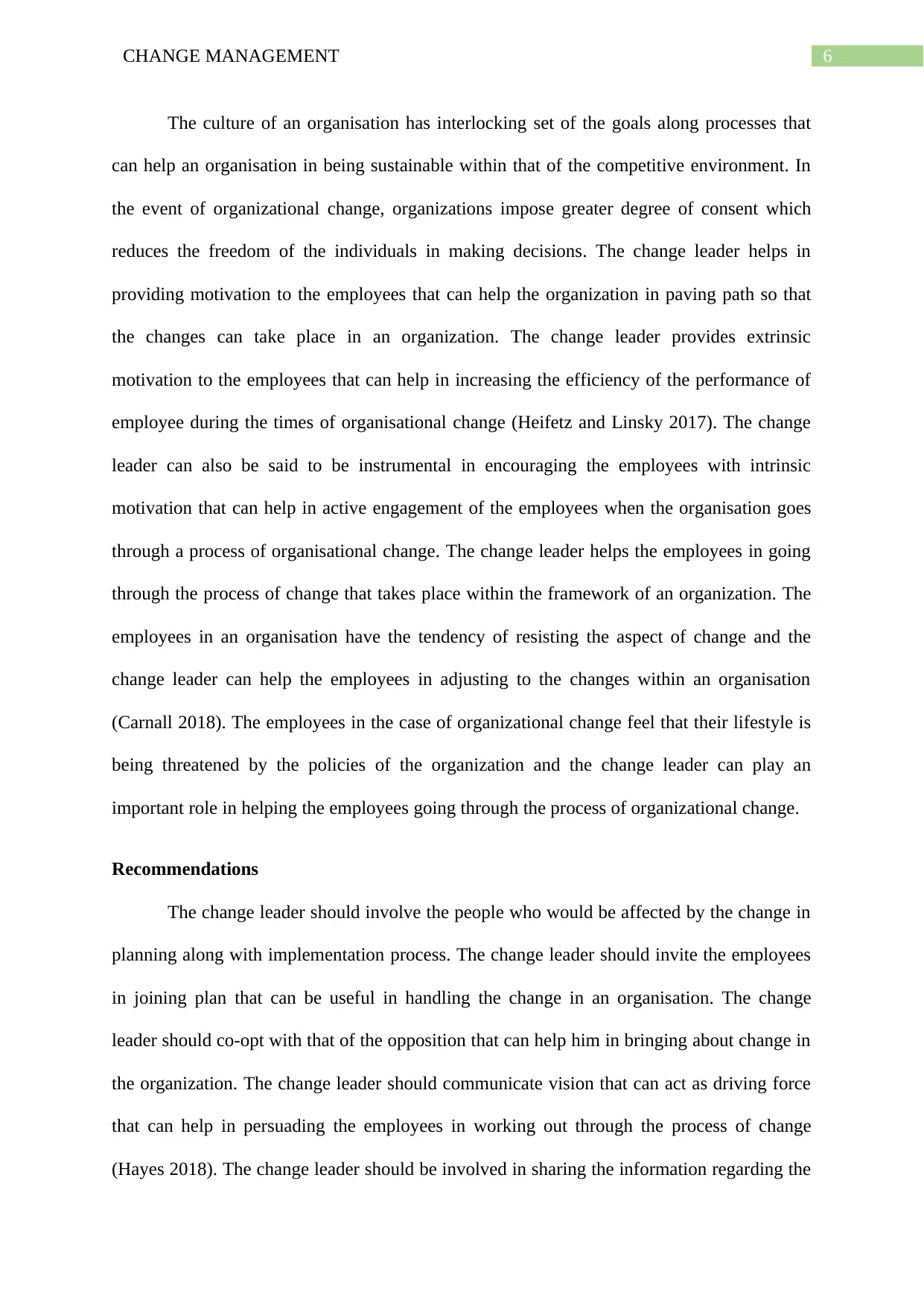
6CHANGE MANAGEMENT
The culture of an organisation has interlocking set of the goals along processes that
can help an organisation in being sustainable within that of the competitive environment. In
the event of organizational change, organizations impose greater degree of consent which
reduces the freedom of the individuals in making decisions. The change leader helps in
providing motivation to the employees that can help the organization in paving path so that
the changes can take place in an organization. The change leader provides extrinsic
motivation to the employees that can help in increasing the efficiency of the performance of
employee during the times of organisational change (Heifetz and Linsky 2017). The change
leader can also be said to be instrumental in encouraging the employees with intrinsic
motivation that can help in active engagement of the employees when the organisation goes
through a process of organisational change. The change leader helps the employees in going
through the process of change that takes place within the framework of an organization. The
employees in an organisation have the tendency of resisting the aspect of change and the
change leader can help the employees in adjusting to the changes within an organisation
(Carnall 2018). The employees in the case of organizational change feel that their lifestyle is
being threatened by the policies of the organization and the change leader can play an
important role in helping the employees going through the process of organizational change.
Recommendations
The change leader should involve the people who would be affected by the change in
planning along with implementation process. The change leader should invite the employees
in joining plan that can be useful in handling the change in an organisation. The change
leader should co-opt with that of the opposition that can help him in bringing about change in
the organization. The change leader should communicate vision that can act as driving force
that can help in persuading the employees in working out through the process of change
(Hayes 2018). The change leader should be involved in sharing the information regarding the
The culture of an organisation has interlocking set of the goals along processes that
can help an organisation in being sustainable within that of the competitive environment. In
the event of organizational change, organizations impose greater degree of consent which
reduces the freedom of the individuals in making decisions. The change leader helps in
providing motivation to the employees that can help the organization in paving path so that
the changes can take place in an organization. The change leader provides extrinsic
motivation to the employees that can help in increasing the efficiency of the performance of
employee during the times of organisational change (Heifetz and Linsky 2017). The change
leader can also be said to be instrumental in encouraging the employees with intrinsic
motivation that can help in active engagement of the employees when the organisation goes
through a process of organisational change. The change leader helps the employees in going
through the process of change that takes place within the framework of an organization. The
employees in an organisation have the tendency of resisting the aspect of change and the
change leader can help the employees in adjusting to the changes within an organisation
(Carnall 2018). The employees in the case of organizational change feel that their lifestyle is
being threatened by the policies of the organization and the change leader can play an
important role in helping the employees going through the process of organizational change.
Recommendations
The change leader should involve the people who would be affected by the change in
planning along with implementation process. The change leader should invite the employees
in joining plan that can be useful in handling the change in an organisation. The change
leader should co-opt with that of the opposition that can help him in bringing about change in
the organization. The change leader should communicate vision that can act as driving force
that can help in persuading the employees in working out through the process of change
(Hayes 2018). The change leader should be involved in sharing the information regarding the
Paraphrase This Document
Need a fresh take? Get an instant paraphrase of this document with our AI Paraphraser
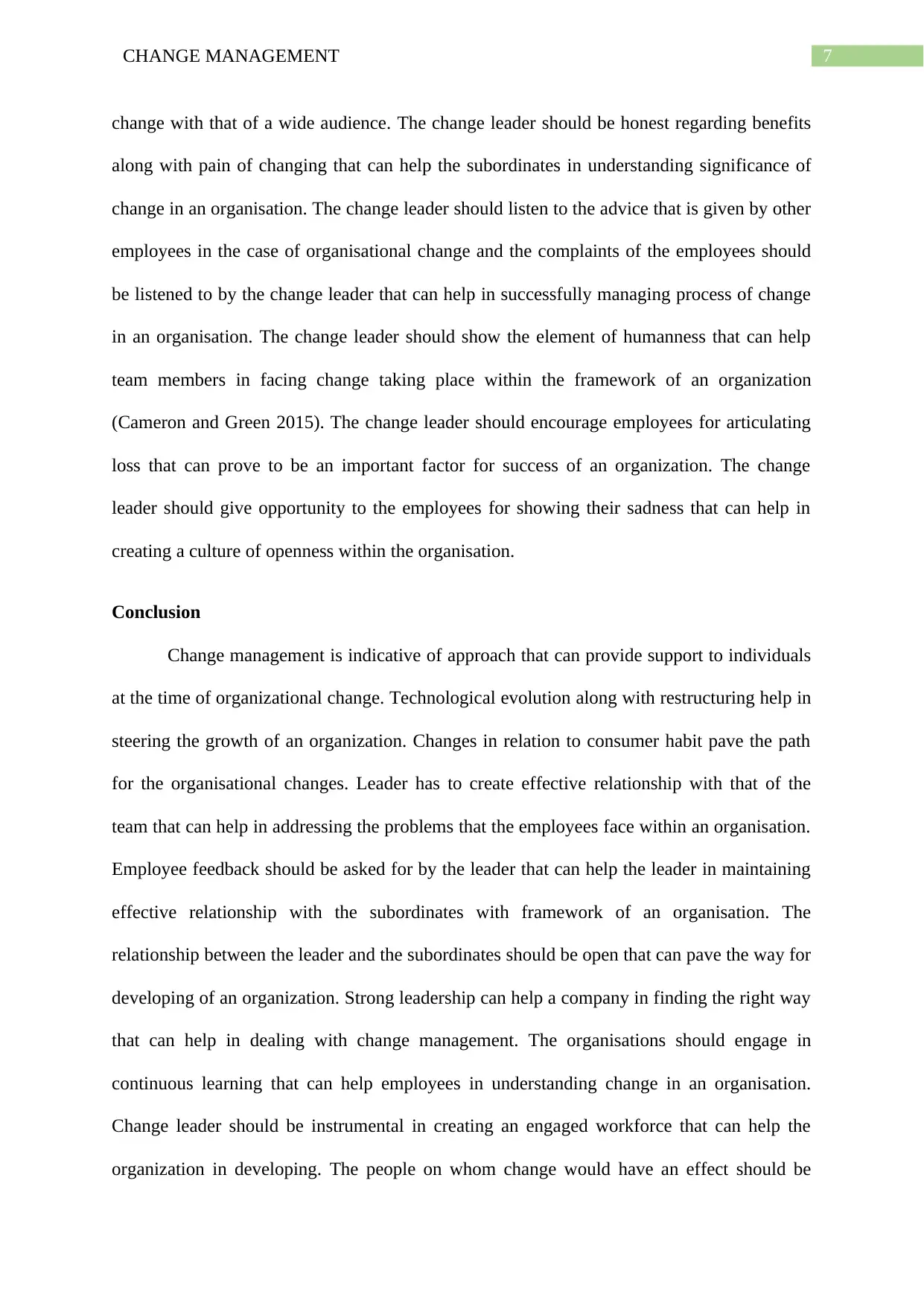
7CHANGE MANAGEMENT
change with that of a wide audience. The change leader should be honest regarding benefits
along with pain of changing that can help the subordinates in understanding significance of
change in an organisation. The change leader should listen to the advice that is given by other
employees in the case of organisational change and the complaints of the employees should
be listened to by the change leader that can help in successfully managing process of change
in an organisation. The change leader should show the element of humanness that can help
team members in facing change taking place within the framework of an organization
(Cameron and Green 2015). The change leader should encourage employees for articulating
loss that can prove to be an important factor for success of an organization. The change
leader should give opportunity to the employees for showing their sadness that can help in
creating a culture of openness within the organisation.
Conclusion
Change management is indicative of approach that can provide support to individuals
at the time of organizational change. Technological evolution along with restructuring help in
steering the growth of an organization. Changes in relation to consumer habit pave the path
for the organisational changes. Leader has to create effective relationship with that of the
team that can help in addressing the problems that the employees face within an organisation.
Employee feedback should be asked for by the leader that can help the leader in maintaining
effective relationship with the subordinates with framework of an organisation. The
relationship between the leader and the subordinates should be open that can pave the way for
developing of an organization. Strong leadership can help a company in finding the right way
that can help in dealing with change management. The organisations should engage in
continuous learning that can help employees in understanding change in an organisation.
Change leader should be instrumental in creating an engaged workforce that can help the
organization in developing. The people on whom change would have an effect should be
change with that of a wide audience. The change leader should be honest regarding benefits
along with pain of changing that can help the subordinates in understanding significance of
change in an organisation. The change leader should listen to the advice that is given by other
employees in the case of organisational change and the complaints of the employees should
be listened to by the change leader that can help in successfully managing process of change
in an organisation. The change leader should show the element of humanness that can help
team members in facing change taking place within the framework of an organization
(Cameron and Green 2015). The change leader should encourage employees for articulating
loss that can prove to be an important factor for success of an organization. The change
leader should give opportunity to the employees for showing their sadness that can help in
creating a culture of openness within the organisation.
Conclusion
Change management is indicative of approach that can provide support to individuals
at the time of organizational change. Technological evolution along with restructuring help in
steering the growth of an organization. Changes in relation to consumer habit pave the path
for the organisational changes. Leader has to create effective relationship with that of the
team that can help in addressing the problems that the employees face within an organisation.
Employee feedback should be asked for by the leader that can help the leader in maintaining
effective relationship with the subordinates with framework of an organisation. The
relationship between the leader and the subordinates should be open that can pave the way for
developing of an organization. Strong leadership can help a company in finding the right way
that can help in dealing with change management. The organisations should engage in
continuous learning that can help employees in understanding change in an organisation.
Change leader should be instrumental in creating an engaged workforce that can help the
organization in developing. The people on whom change would have an effect should be
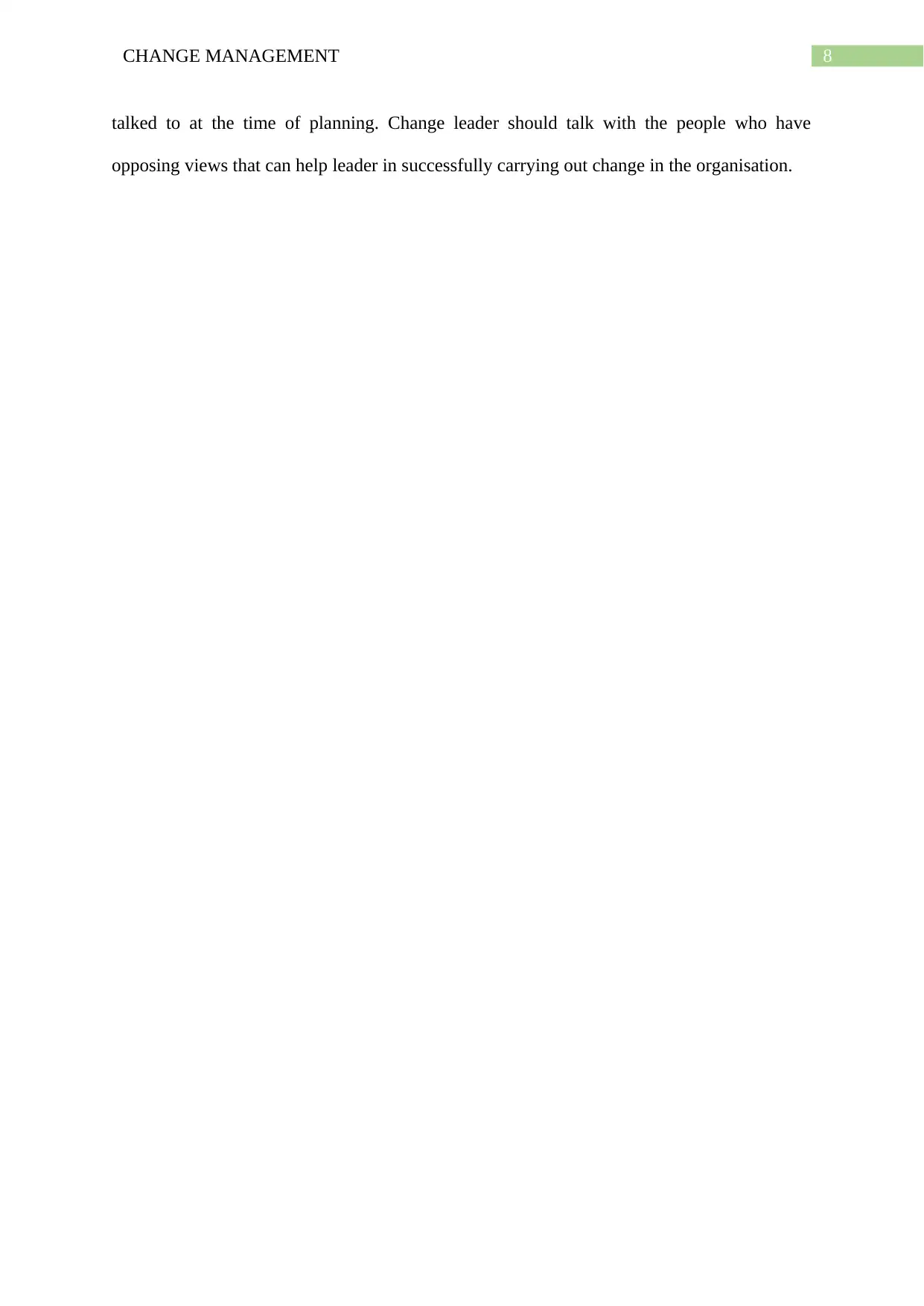
8CHANGE MANAGEMENT
talked to at the time of planning. Change leader should talk with the people who have
opposing views that can help leader in successfully carrying out change in the organisation.
talked to at the time of planning. Change leader should talk with the people who have
opposing views that can help leader in successfully carrying out change in the organisation.
⊘ This is a preview!⊘
Do you want full access?
Subscribe today to unlock all pages.

Trusted by 1+ million students worldwide
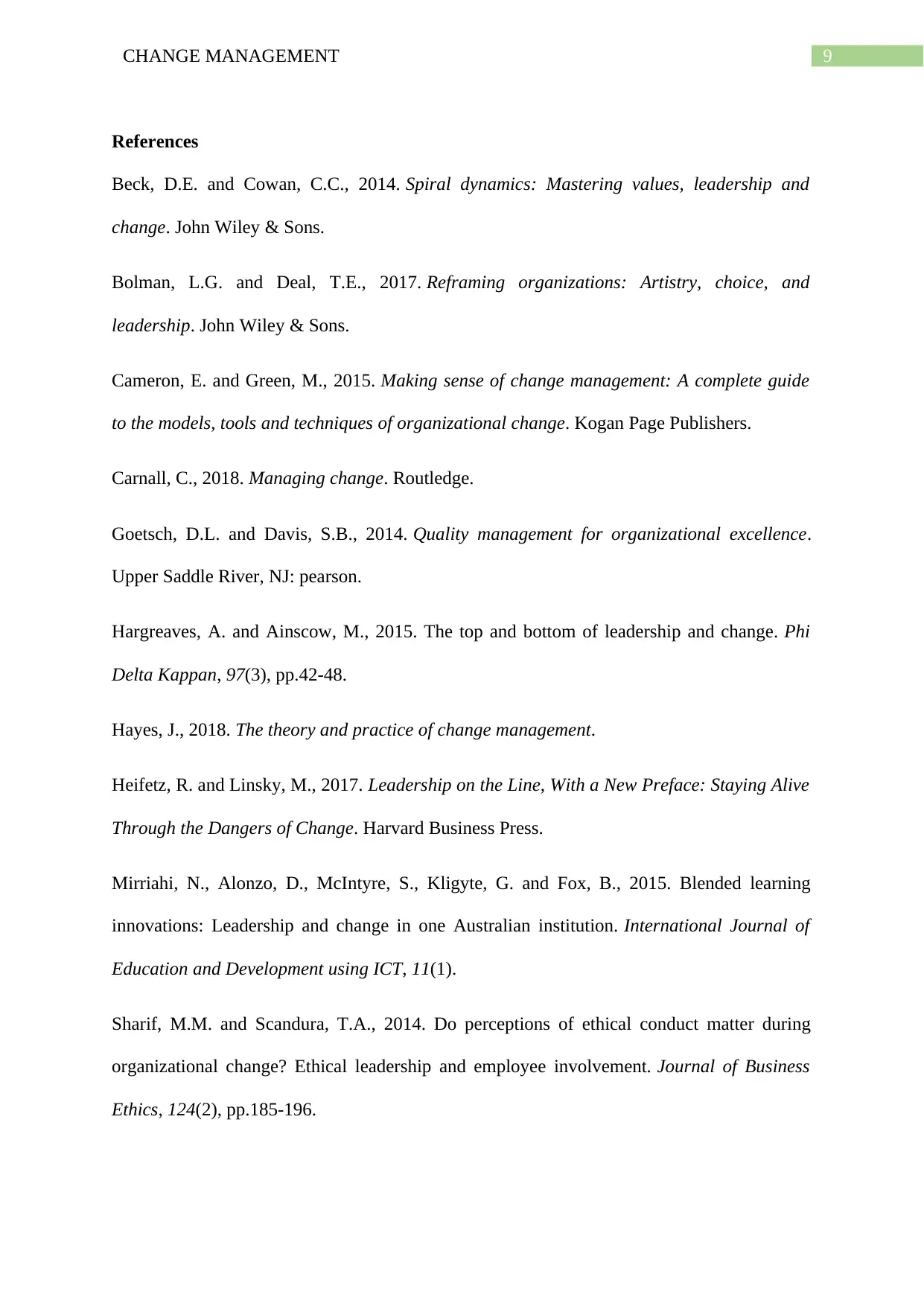
9CHANGE MANAGEMENT
References
Beck, D.E. and Cowan, C.C., 2014. Spiral dynamics: Mastering values, leadership and
change. John Wiley & Sons.
Bolman, L.G. and Deal, T.E., 2017. Reframing organizations: Artistry, choice, and
leadership. John Wiley & Sons.
Cameron, E. and Green, M., 2015. Making sense of change management: A complete guide
to the models, tools and techniques of organizational change. Kogan Page Publishers.
Carnall, C., 2018. Managing change. Routledge.
Goetsch, D.L. and Davis, S.B., 2014. Quality management for organizational excellence.
Upper Saddle River, NJ: pearson.
Hargreaves, A. and Ainscow, M., 2015. The top and bottom of leadership and change. Phi
Delta Kappan, 97(3), pp.42-48.
Hayes, J., 2018. The theory and practice of change management.
Heifetz, R. and Linsky, M., 2017. Leadership on the Line, With a New Preface: Staying Alive
Through the Dangers of Change. Harvard Business Press.
Mirriahi, N., Alonzo, D., McIntyre, S., Kligyte, G. and Fox, B., 2015. Blended learning
innovations: Leadership and change in one Australian institution. International Journal of
Education and Development using ICT, 11(1).
Sharif, M.M. and Scandura, T.A., 2014. Do perceptions of ethical conduct matter during
organizational change? Ethical leadership and employee involvement. Journal of Business
Ethics, 124(2), pp.185-196.
References
Beck, D.E. and Cowan, C.C., 2014. Spiral dynamics: Mastering values, leadership and
change. John Wiley & Sons.
Bolman, L.G. and Deal, T.E., 2017. Reframing organizations: Artistry, choice, and
leadership. John Wiley & Sons.
Cameron, E. and Green, M., 2015. Making sense of change management: A complete guide
to the models, tools and techniques of organizational change. Kogan Page Publishers.
Carnall, C., 2018. Managing change. Routledge.
Goetsch, D.L. and Davis, S.B., 2014. Quality management for organizational excellence.
Upper Saddle River, NJ: pearson.
Hargreaves, A. and Ainscow, M., 2015. The top and bottom of leadership and change. Phi
Delta Kappan, 97(3), pp.42-48.
Hayes, J., 2018. The theory and practice of change management.
Heifetz, R. and Linsky, M., 2017. Leadership on the Line, With a New Preface: Staying Alive
Through the Dangers of Change. Harvard Business Press.
Mirriahi, N., Alonzo, D., McIntyre, S., Kligyte, G. and Fox, B., 2015. Blended learning
innovations: Leadership and change in one Australian institution. International Journal of
Education and Development using ICT, 11(1).
Sharif, M.M. and Scandura, T.A., 2014. Do perceptions of ethical conduct matter during
organizational change? Ethical leadership and employee involvement. Journal of Business
Ethics, 124(2), pp.185-196.
Paraphrase This Document
Need a fresh take? Get an instant paraphrase of this document with our AI Paraphraser
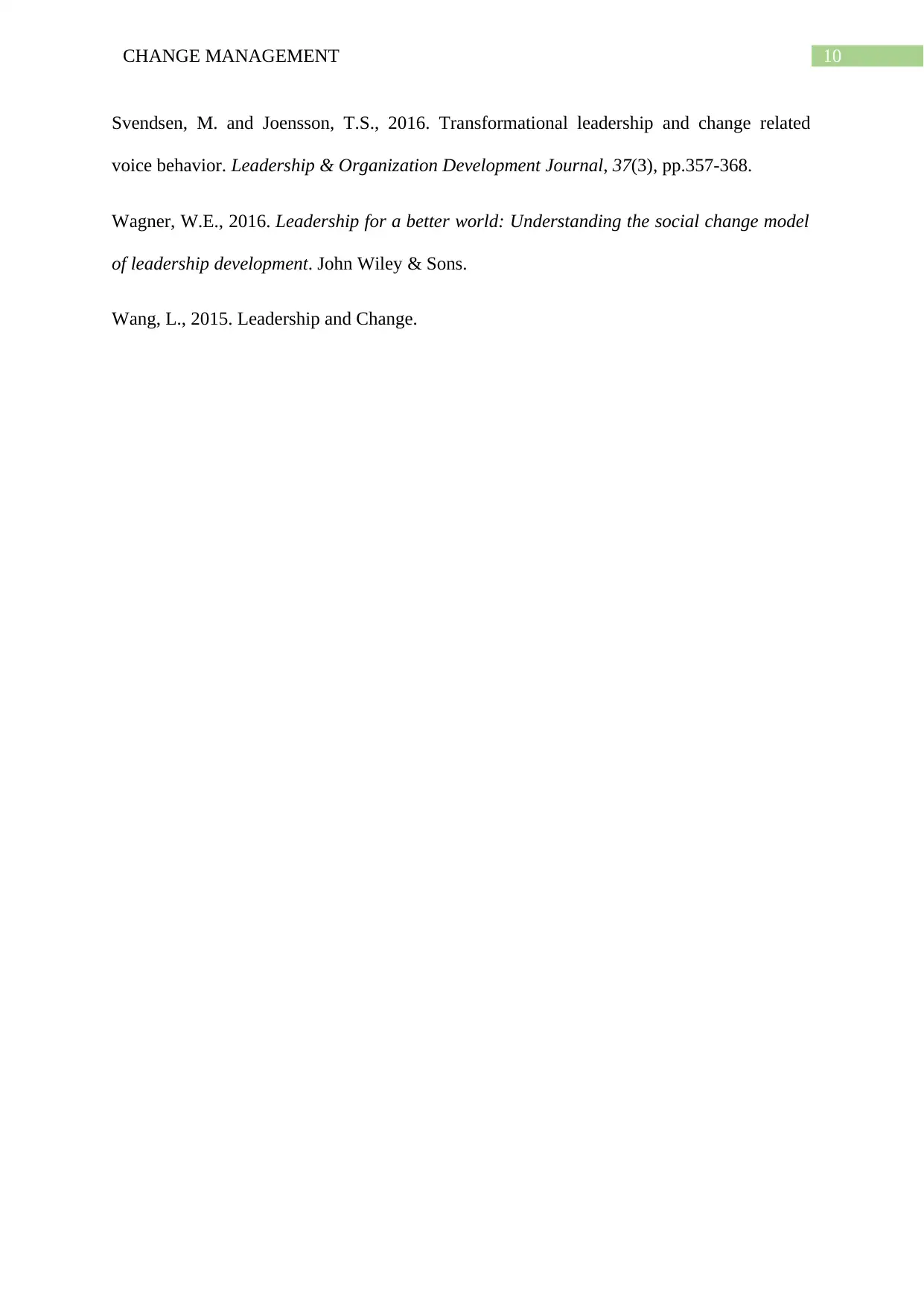
10CHANGE MANAGEMENT
Svendsen, M. and Joensson, T.S., 2016. Transformational leadership and change related
voice behavior. Leadership & Organization Development Journal, 37(3), pp.357-368.
Wagner, W.E., 2016. Leadership for a better world: Understanding the social change model
of leadership development. John Wiley & Sons.
Wang, L., 2015. Leadership and Change.
Svendsen, M. and Joensson, T.S., 2016. Transformational leadership and change related
voice behavior. Leadership & Organization Development Journal, 37(3), pp.357-368.
Wagner, W.E., 2016. Leadership for a better world: Understanding the social change model
of leadership development. John Wiley & Sons.
Wang, L., 2015. Leadership and Change.
1 out of 11
Related Documents
Your All-in-One AI-Powered Toolkit for Academic Success.
+13062052269
info@desklib.com
Available 24*7 on WhatsApp / Email
![[object Object]](/_next/static/media/star-bottom.7253800d.svg)
Unlock your academic potential
Copyright © 2020–2025 A2Z Services. All Rights Reserved. Developed and managed by ZUCOL.





